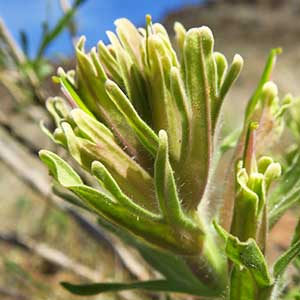Castilleja xanthotricha
Castilleja exserta
John Day or yellow-hairy paintbrush, John Day paintbrush, yellow hair paintbrush, yellow-hair Indian paintbrush
castilleja exserta, escobita, exserted Indian paintbrush, owl's clover, purple owl's-clover, purple painted-cup
few to several, ± decumbent to erect or ascending, unbranched, sometimes with short, leafy axillary shoots, hairs erect to spreading, long, soft, eglandular, mixed with short stipitate-glandular ones.
solitary, erect to ascending, unbranched or diffusely branched from near base, hairs spreading, medium length and long, stiff, mixed with short stipitate-glandular ones.
green, linear, lanceolate to broadly lanceolate, oblong, or cuneate, 0.8–5 cm, not fleshy, margins plane to wavy, involute, 0–5-lobed, apex acute, sometimes rounded;
lobes spreading, linear, arising below mid length, nearly as broad as center lobe, apex acute.
green, sometimes purple to brownish, linear or ovate to orbicular in outline, (0.8–)1–5(–7.7) cm, not fleshy, margins plane, involute, (0–)3–9(–11)-lobed, sometimes with secondary lobing, apex acuminate to rounded or acute;
lobes spreading, filiform or linear to narrowly spatulate, apex acute to acuminate or rounded.
3–14 × 1.5–4.5 cm;
bracts proximally greenish, rarely dull reddish purple, distally white to cream, rarely pale yellow or dull, pale pink (sharply differentiated from proximal coloration), lanceolate or oblong to narrowly ovate, (3–)5–7-lobed;
lobes ascending, linear to obovate, ± broadened distally, medium, long, proximal lobes arising below mid length, central lobe apex broadly rounded to truncate, others acute to rounded.
1.5–20 × 2–4 cm;
bracts proximally greenish, dark purple, brownish purple, or white, distally pink, lavender, magenta, light purple, or white on lobe apices, lanceolate to elliptic or narrowly ovate, (3–)5(–9)-lobed, often with 2–4 secondary lobes;
lobes ascending to spreading, linear to filiform or narrowly spatulate, medium length to long, arising below or above mid length, apex rounded to acute.
curved, 17–23 mm;
tube 15–19 mm;
beak exserted, adaxially green, 5–8(–9) mm, puberulent, stipitate-glandular;
abaxial lip deep purple (color sometimes visible through calyx), green, pinkish, or pale yellow, ± prominent, slightly inflated, usually hidden in calyx, sometimes right at top of calyx, 2 mm, ca. 50% as long as beak;
teeth ascending, whitish, yellowish, pink, or green, 1–1.5 mm.
straight, 12–33 mm;
tube 7–20 mm;
beak slightly exserted, hooked near apex, adaxially pink-purple to magenta, rarely white, 5–13 mm, margins colored as bracts, densely villous-hairy;
abaxial lip proximally pink, purple, or magenta, rarely yellow or white, with maroon or deep purple distal to that and white to yellow or pink distally, often with purple spots, distal pale color often aging deep pink or deep red, strongly inflated, pouches 3, 3–8 mm wide, 3–4 mm deep, 3–9 mm, 67–80% as long as beak;
teeth erect, white, yellow, or purple, often with purple or maroon spots, 0.5–2 mm.
colored as bracts, 15–26 mm;
abaxial and adaxial clefts 3.5–7 mm, 25–50% of calyx length, deeper than laterals, lateral 2–5 mm, 12–25% of calyx length;
lobes linear, oblong, or narrowly triangular, center lobe apex usually rounded, lobes acute to rounded.
colored as bracts, 10–26 mm;
abaxial clefts 4–12 mm, adaxial 9–18 mm, abaxial ca. 50% of calyx length, adaxial ca. 67% of calyx length, at least adaxial deeper than others, lateral 2.5–9 mm, 15–45% of calyx length;
lobes linear (to narrowly oblanceolate), apex rounded to acute.
with spreading, long, soft hairs.
= 48.
= 24.
Castilleja xanthotricha
Castilleja exserta
Castilleja xanthotricha is endemic to moderate elevations in the sagebrush hills of the John Day River drainage in north-central Oregon. N. H. Holmgren (1971) hypothesized that this tetraploid species is of allopolyploid hybrid origin between C. glandulifera and C. oresbia.
(Discussion copyrighted by Flora of North America; reprinted with permission.)
Varieties 3 (3 in the flora).
In addition to the characters in the key, Castilleja exserta is distinguished from the similar C. densiflora by its conspicuously hairy and apically hooked beak. As a result, the capitate stigma is exserted more or less horizontally from the corolla beak. In contrast, C. densiflora has an unhooked, inconspicuously puberulent beak, from which the stigma emerges more vertically. Castilleja exserta hybridizes with C. attenuata in southern California and with C. lineariloba in central California, and it reportedly crosses occasionally with C. densiflora in southern California.
(Discussion copyrighted by Flora of North America; reprinted with permission.)
1. Abaxial lips of corollas deep red-purple proximally, with distal 1/4 bright yellow to yellow-orange, becoming orange or red after anthesis; w Mojave Desert, California. | var. venusta |
1. Abaxial lips of corollas variably colored, proximally pink to deep red-purple or white, with distal 1/4–1/3 white, yellow, or yellow-orange; widespread in Arizona and California, rare in New Mexico or limited to the coastal regions of California. | → 2 |
2. Bracts usually less than 5 mm wide, lobes filiform to linear; inland and near-coastal grasslands and meadows; Arizona, w California, sw New Mexico. | var. exserta |
2. Bracts 5–7 mm wide, lobes linear to narrowly spatulate; coastal dunes and bluffs; California. | var. latifolia |
- Local floras:
CA,
OR,
WA
- Local Web sites:
CalFlora,
CalPhotos,
Flora NW,
PNW Herbaria
WildflowerSearch
iNaturalist (observations)
USDA Plants Database
- LBJ Wildflower Center
- SEINet
- Plants of the World Online
- Encyclopedia of Life
- Wikipedia
- Google Image Search
